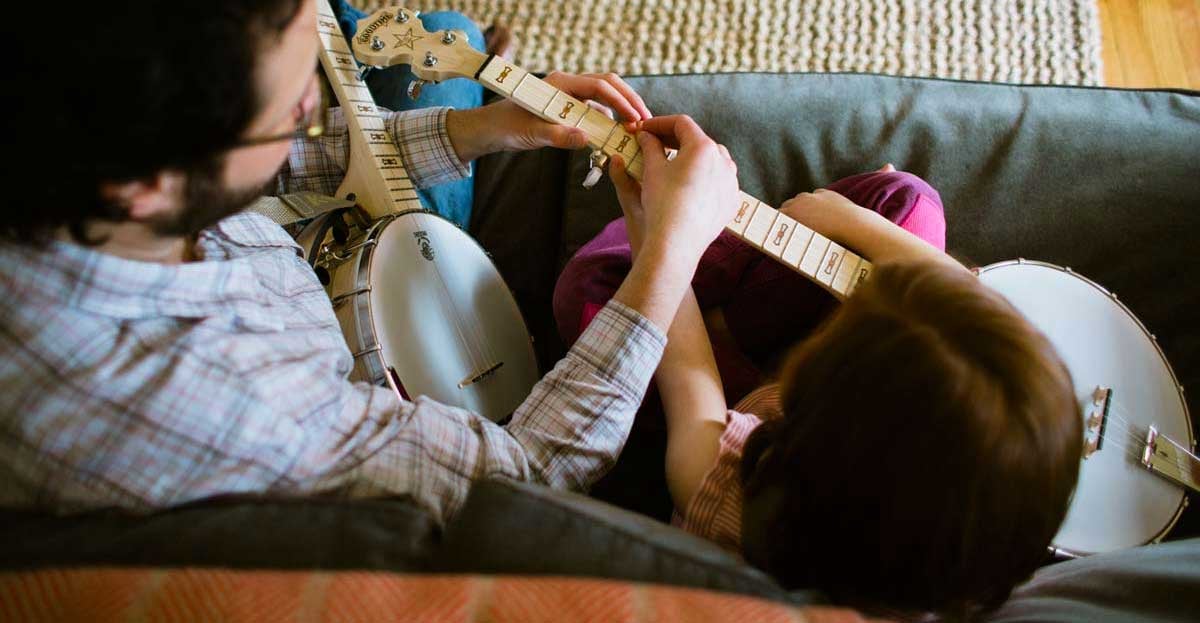
One of the most daunting parts about starting a new hobby or craft is knowing where to begin. The choices of what you need, what to look for, what brands are good quality, etc. can sometimes be so overwhelming that you decide not to begin on your adventure of learning something new at all.
Learning how to play the banjo is no different. There are different types of banjos and plenty of new terminology for parts of banjos and playing styles. Aspiring players also wonder what makes one banjo better than another.
In this guide, we strive to provide a firm introduction of all things banjo. We have provided links throughout the guide that will allow you to delve deeper into the subject in question. We hope that we are able to answer your questions here for you so your entrance into the banjo world is an easy one.
Let's get started by looking at the many different types of banjos available.
The first thing you need to understand is that there are several different types of banjos that are each traditionally used for different genres of music, that are tuned differently, and played differently using different techniques. There are tenor banjos, plectrum banjos, 5 string banjos, 6 string banjos, and banjo ukuleles. In the early 20th century there were other hybrid banjo instruments such as banjolins (banjo/mandolin). But what do they all sound like? How are they different? Let’s have a look.
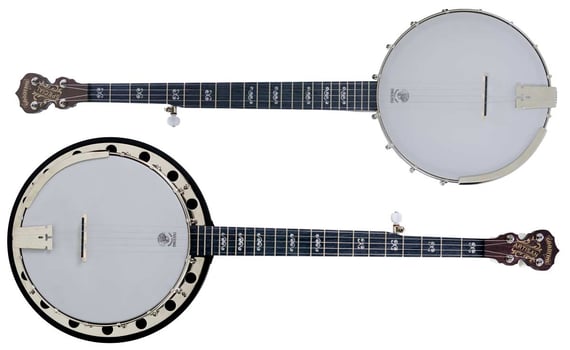
Throughout the course of your journey, you will hear a lot of new terms, including "openback" and "resonator".
A resonator is the back of a banjo that helps to reflect the sound out to your audience, thus making the banjo sound louder and brighter. In certain styles of music where the banjoist will take a solo, such as in bluegrass or jazz, a resonator would be preferred because you want to be able to be heard, against the rest of the band when you step out to take a solo.
On the other hand, the openback is exactly what the name suggests. It has no resonator and therefore, an open back. Folk musicians or singer songwriters commonly pick up the openback for a milder, more graceful approach.
It is important to note that any type of banjo can be either an openback or a resonator banjo.
The most important thing to keep in mind is that although you will read and hear endless opinions that certain banjos are for certain styles, or that the only "real" banjo is a 5 string banjo, these are merely guidelines. The reality is this is music. Yes, some types of banjo will be more suited for what you are trying to achieve than others, but this is still music. Last time we checked, music and the creativity that lies within, was never supposed to be bound by rules. You can play whatever style on whatever banjo you like so long as it sounds good to you.
95% of the time, when a person tells us, “I want to play the banjo”, the type of banjo they are usually referring to is a 5 string banjo. The 5 string banjo is the primary type of banjo and is the most commonly known.
The type of music traditionally played on a 5 string banjo is bluegrass and folk music. Other styles such as ragtime and blues have been played on it throughout it’s history. In the past 30 plus years with groundbreaking artists such as Bela Fleck, the traditional styles have been blown up and modern jazz, classical, world music, and more have been played at a very high level on the banjo.
A more recent phenomenon is the 5 string banjo being used in different variations of rock bands. Folk rockers like Mumford & Sons (check out their banjo style), the Avett Brothers, and more recently, Judah & the Lion have brought the 5 string banjo to huge new audiences, by using banjo to create a completely new dynamic in their sound.
Typically, when starting out on the 5 string banjo, you will be introduced to one of two styles. 3 finger style would be reminiscent of a bluegrass/Earl Scruggs style and is normally played on a resonator banjo with a heavy tone ring. The player would wear two finger picks and a thumb pick and pluck the strings using a technique called "rolls".
At the other end of the spectrum, clawhammer is normally played on an openback banjo, and the player tends to use his/her thumb and index or middle finger (players usually choose either the index or middle finger and stick to it), striking the string with the back of the nail on the index or middle finger instead of finger picks. Some players might use a fingerpick to get a brighter sound or if their nail is broken or worn down. Other players sometimes put an acrylic nail on. The player uses his hand in an up/down motion to create a rhythmic, almost hypnotic style of playing. The thumb and index or middle finger are positioned in such a way that it quickly becomes apparent why it is called "clawhammer." This style of play is also called "frailing".
Banjo power couple Bela Fleck and Abigail Washburn offer a wonderful explanation on the differences between the two, which we encourage you to watch for a more in depth look.
Learn how to tune the 5 string banjo and all types of banjos here.
Tenor banjos are tuned in 5ths the same way a violin, viola, cello or other instruments from the string family would be. Mandolins use this same type of tuning. This type of banjo is traditionally used for early traditional jazz or Irish music. Traditional jazz tenor banjo players tune the banjo C,G,D,A like a viola and most will use a 19 fret tenor banjo. Jazz tenor players typically will use a flatpick to strum chords and play single note lines. When taking a solo, often tenor banjo players will use what is called a chord melody solo.
Learn about 10 great tenor banjo players in the early jazz style here
Generally, 17-fret tenor banjos are used by children and people with small hands who find the smaller scale length makes it more manageable to play. Some players like the smaller scale length for the ease of playing in an armchair or for easier travel size.
Learn what the standard is for Irish Tenor banjo here
What is a Plectrum Banjo?
After the tenor banjos, the other 4 string banjo is the plectrum. The easiest way to understand a plectrum banjo is to imagine it as a 5 string banjo without the 5th string. It has the same number of frets as the 5 string banjo and its tuning is very similar to the standard 5 string tuning of open G, except the 4th string is tuned down to a C, instead of the D.
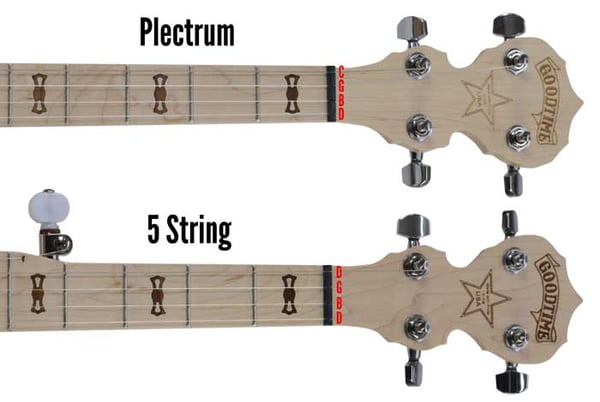
This makes the tuning C,G,B,D, instead of D,G,B,D that you have on the top four strings of a 5 string banjo. Like the tenors, this type of banjo is played with a flat pick or “plectrum” and is commonly used for traditional jazz.
The plectrum banjo is also sometimes used for other styles of music such as folk, for those who wish to strum the banjo rather than using finger picks. In this case, the plectrum is often favored since you won’t accidentally hit the 5th string every time you strum.
As you start to go deeper into the plectrum world, you will inevitably stumble on the term "Chicago tuning". Chicago tuning is a way of tuning a plectrum banjo like the top 4 strings of a guitar. This would make the tuning D,G,B,E making the plectrum an easy crossover instrument for guitar players.
We do get asked if this tuning can be achieved on a tenor banjo. The simple answer is that although it can be done on tenor banjos, it normally requires some changes in string gauge, which is why it is much easier to achieve with a plectrum.
Learn what to look for in a plectrum banjo here
Banjo Ukuleles
Despite the obvious similarity in the number of strings, banjo ukuleles are typically not grouped in with the other 4 string banjos because it is more of a hybrid instrument. These banjos are exactly what you would imagine them to be; they are ukulele necks mounted to a banjo body.
Banjo ukuleles are tuned like a regular ukulele and are strung with the same nylon strings, thus you get a tone somewhere between that of a ukulele and a banjo. With that, the banjo ukulele's are great for those who play the ukulele and want another tone in their arsenal.
Like ukuleles, these are seriously addictive and a lot of fun to play and a great addition to any uke enthusiasts collection.
6 string banjos are another hybrid banjo that merges a guitar neck with a banjo body and are tuned and played just like a guitar. These banjos often get a bad rap for not being a “real” banjo, suggesting that one would be cheating by playing a 6 string banjo and not learning 5 string. This couldn’t be further from the truth. The 6 string banjo has been around for over 100 years and has made major contributions to American music. Louis Armstrong’s banjo player, Johnny St. Cyr, Reverend Gary Davis, and Danny Barker famously played 6 string banjos. Before the electric guitar came along in the 1930’s, guitar players would play the banjo when they needed to be heard.
Today, 6 string banjos are used by guitarists to get a banjo tone in many different genres. Artists as diverse as guitar heroes Joe Satriani, Keith Urban, Rod Stewart, through to Taj Mahal, and pop sensation Taylor Swift have all built the 6 string banjo into their sound. Guitarists are always searching for new tones with pedals and different types of guitars, and the 6 string banjo should be thought of no differently. It gives guitarists another tone in their arsenal.
Listen to six great 6 string banjo songs!
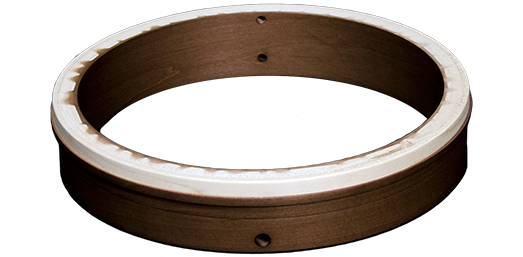
The rim is the round part of the banjo. It can be made out either wood or metal. The majority of banjos have a wooden rim with the best banjos usually having a 3 ply maple rim. More ply's in the rim require more glue which ultimately dampens the tone.
The type of wood used is not always the same though. Traditionally banjo companies used hard rock maple. Deering moved to using only 3 ply violin grade maple on all of their banjos with a wooden rim in 2007 after extensive testing. They found the violin grade maple responded better than the hard rock maple and gave the banjo a fuller, richer tone than hard rock maple.
In 2017 Deering discovered the unique sound qualities of white oak rims, now included in their offerings.
Some banjos have a metal rim or a combination of a thin wooden rim and a metal shell. Just as in the wooden rims, not all metal used is the same. Some banjo companies use aluminum for their metal rims. This results in a dull, twangy tone. Deering uses a metal rim on the Deering Boston banjos. The metal used on this rim is steel and gives the banjo a crisp, bright tone.
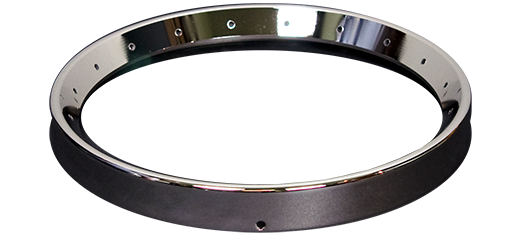
A tone ring is a ring that is made of metal which is fitted very precisely to the top of the rim of the banjo, sitting underneath the banjo head. To learn more about what a banjo tone ring does, we have to take a quick physics lesson. When the strings are plucked, they vibrate. These vibrations travel through the banjo bridge, through the banjo head, causing the tone ring to resonate, and essentially to ring out like a bell. This magnifies the tone of the banjo, usually adding brightness and depth to the tone.
However, this depends on a variety of factors, including the metallurgy (the scientific name for what metals are in a tone ring), the shape and geometric of the tone ring. Materials make a big difference, also. A wooden tone ring, such as the grenadillo tone ring found in the Deering Hartford Model, offers a noticeably more rounded tone than its metal counterpart. The result is a great number of different tone rings for different styles, all of which make their own statement.
It is worth noting that not all banjos have tone rings and having one does not necessarily make it better. It just gives the banjo an alternative voice that suits the players sound.

The banjo neck is generally made of wood and the length of the neck will vary according to the type of banjo and the scale. Inlays on the front of the neck/fingerboard act as “landmarks” to help the player navigate the neck without having to count the frets during the course of play.
Underneath the fingerboard of the neck is where the truss rod is located. The truss rod helps stabilize the neck and allows adjustability of the string height above the fingerboard. When a banjo neck is made of one piece of solid hardwood or two pieces of the same hardwood it does not need a truss rod and the string height can be adjusted in other ways.
Neck profiles are important too. This refers to the shape/depth/width of the neck itself as it sits in your hand. Try some. Which feels more comfortable? Which is easiest to maneuver around? Does it feel big and do you struggle to wrap your hand around it? If so, chances are this will only make playing it more challenging.

The fingerboard is part of the neck of a banjo. It is mounted on the top side of the neck and is made of a hard and durable wood such as ebony because the fingerboard gets the most wear during play from the metal strings.
Ebony has always served as a great option for fingerboard wood as it is incredibly dense and hard wearing. Think of an orchestra and all the fingerboards of the stringed instruments are made of ebony for that same reason.
However, in recent years over harvesting has resulted in a decline in the availability of ebony, and thanks to the work of Bob Taylor and Taylor Guitars, Cameroon is one of the last places on earth where ebony is readily available. While Deering still uses ebony on most of its upper line models, we have also introduced Midnight Maple; a dark stained form of hard rock maple, which is incredibly dense and requires a special, proprietary process in order to fully penetrate the tight grain of the wood with the dark stain.
Aside from the hard playing surface, the fingerboard is where the frets are mounted, as well as inlay markers. These can vary from simple dots, to elaborate, imagination fueled designs.
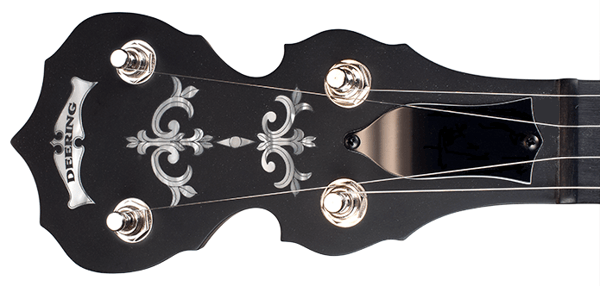
The top of the neck is called the peghead. This is because the tuning pegs are located in this area of the neck. At the base of the peghead you will find the “nut”, a small ledge, normally made of ebony, bone, or a suitable synthetic, that has slots in it for the banjo strings. The nut is where the strings are aligned before they travel down the fingerboard of the banjo.
The spacing of the slots is obviously important to align the string spacing correctly. But the depth of the slots is equally as important. Too shallow, and the strings will pop out of their slot during playing. Too deep and you will likely start to hear some buzzing as the string rattles against the frets, or inside the nut.
What are Tuners?
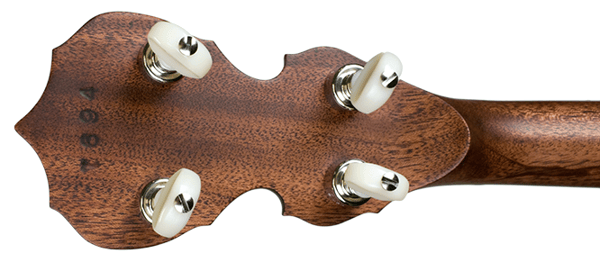
Tuners, sometimes known as tuning pegs typically come in two styles on modern banjos.
With tuners, you are looking for reliability and accuracy. You want the banjo to stay in tune, and you want to be able to tune them easily. In other words, as a beginner, you might favor guitar style tuners since they can be turned quite far without adjusting the pitch. Planetary tuners on the other hand, are a lot more sensitive. A slight turn can mean quite a big jump in pitch.
Also, check for whether the gears are sealed, or open. All tuners at Deering are sealed and geared to make them more stable.
The pot assembly refers to the completed "body" of the banjo, composed of all of its various parts. The pot assembly is formed before the neck and resonator are added.
It begins with the foundation; the rim. With the rim ready, we add the tone ring (if called for), the banjo head, a tension hoop with corresponding hooks and nuts to provide tension on the banjo head, the tailpiece, and an armrest. On a resonator banjo it will include the flange, which serves to attach the resonator back.
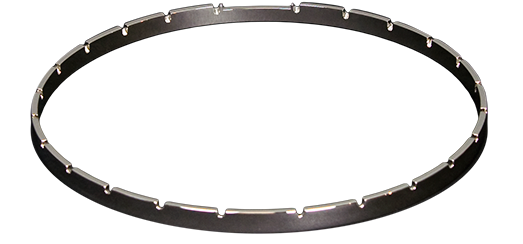
The function of the tension hoop is to keep the banjo head tight. It is pulled over the head and is tightened by a series of hooks and nuts that are adjusted until the desired tension is reached. If you are familiar with drums, it is a similar system.
Some tension hoops are "notched" to accommodate each "round hook" for greater stability. Others are not, and utilize a beveled edge and "flat hooks" for stability. Deering tension hoops are made of brass or steel, depending on the model, and are all made in our factory in Spring Valley, CA.
What is the Head?
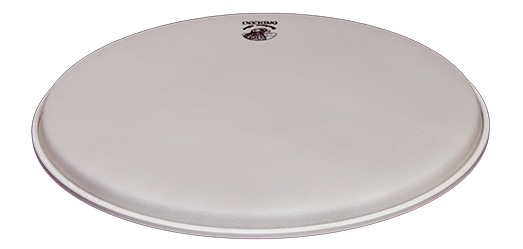
The banjo head is the key to making a banjo what it is. A banjo is defined by the idea of stretching a membrane over a frame. The head is the vibrating membrane that acts as a soundboard. In the past, this would have been a calf skin or goat skin, but most makers switched to a mylar alternative somewhere around 1950.
Different banjo heads can create different sounds due to the thickness of the mylar membrane, giving the banjo player further options in tone. There are even modern mylar heads that mimic the calf skin sound.
As a rule of thumb, bluegrass players and jazz players will typically prefer a frosted head for that bright, crisp sparkle that it adds to the tone. Meanwhile, folk/clawhammer players prefer a thicker, duller sound and will often opt for a skin style head.
Deering banjo heads are made in California and are crimped for greater durability.
What is the Flange?
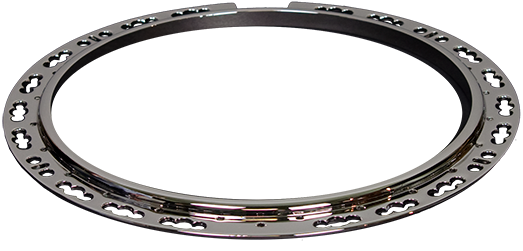
The flange is the decorative metal section that sits in between the edge of the rim and the edge of the resonator. The flange serves three purposes.
What is the Resonator?
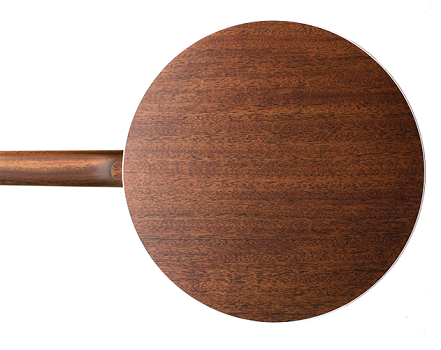
The resonator or back of the banjo is there to make the banjo louder by acting as a sounding board. The resonator projects the sound that the banjo makes forward rather than have it be absorbed by the body of the player or dissipating out the back and around the rim as in an openback banjo.
When you are in your local music store, you should also make a point of looking at the back of a resonator. They also make a great area to highlight some spectacular woods and inlay work.
The 3 finger style of playing the 5 string banjo wasn’t invented by Earl Scruggs, but he did refine it and is the person most attributed to this style of playing. There are a few different playing styles which fall into the 3 finger style, but the most popular is a style where the player utilizes a series of "roll" patterns. This "roll" pattern style became known as "Scruggs Style". The 3 finger style of playing the 5 string banjo is closely linked to bluegrass banjo. This is the most common style of playing the banjo and makes a great introductory style to playing bluegrass for most new players.
Other styles that fall into the 3 finger style of playing are the melodic style (sometimes called the Keith style) and the single string style (often called Reno style - named for the famed 5 string banjo player Don Reno).
The 3 finger style is played while wearing fingerpicks on the thumb, index, and middle finger of the right hand (assuming you are right handed).
3 finger style is arguably the most versatile style of playing. Grammy winning banjoist Noam Pikelny offers a marvelous presentation on the three styles which is well worth the watch.
Learn how to play 3 finger style banjo here!
Clawhammer or frailing on the 5 string banjo is most often used for old time Appalachian music. In this style, picks are not worn. It is called clawhammer because your picking hand is essentially in the shape of a claw. Here, all of the notes are down picked by your thumb and either your middle or index finger. I suggest you choose either your middle or index finger and stick with just that finger for now.
The basic pattern of this style is less technical than the 3 finger style and has become more and more popular these days. Because you have more strums involved when playing this style, it fills out the tone more so that when you are playing by yourself. It also has a great rhythmic pulse to it.
Learn how to play Clawhammer banjo here!
This style is similar to the 3 finger style but you are just using your thumb and index finger. The thumb basically plays the melody line in this style and the index finger fills out the sound by playing other chordal tones.
Click here to learn more about this style.
Traditional Jazz (Tenor, Plectrum, 6 String Banjo)
Before the electric guitar came along, banjo dominated jazz music as it was louder and could be heard when playing with a combo that included horns, drums, bass, and piano. Early jazz banjoisits from New Orleans, where jazz was born, played either tenor, plectrum, or 6 string banjo. All of these banjos in this style would be played with a flatpick and mostly would strum chords to accompany the melody played by the horn section. If the banjoists took a solo he/she would most often play a chord melody.
Learn how to play a chord melody on the tenor banjo
As this style progressed, banjoists such as Eddie Peabody, Harry Reser, and Elmer Snowden started taking the banjo into the spotlight and would showcase some pretty incredible solo techniques and single line passages.
Banjoists playing Irish music most commonly play a tenor banjo. They vary on whether to use a 17 fret or 19 fret tenor, but the playing technique is the same. These banjoists play with a flatpick and for the most part play single note melodies.
VIDEO COMING SOON
For guitar players, the six string banjo opens up a myriad of options and tones to their repertoire. Some say the 6 string banjo is merely "cheating"; an easy way out of having to learn a new instrument. But that is not the case, and the 6 string banjo has been holding its own as an established instrument for a long time.
And while guitarists can easily transition to the 6 string banjo, many have cited the use of a 6 string banjo to inspire creativity in their playing and to take a different approach to their playing, maybe trying ideas they have never tried before. Certainly, established and respected guitarists such as Keith Urban have spoken of the effect the 6 string banjo had on the direction of a song, that wouldn't have materialized simply with a guitar.
The importance of a high quality instrument is greater as a beginner, than at any other time during your journey.
A bold statement, for sure. But think about it. Experienced players know how to play. When they come up against an issue, they are far more likely to know when that issue is being caused by something in the instrument or when it is being caused by their technique. As a beginner, you will not yet have a developed technique and so it becomes an almost natural reaction that you might blame yourself for not playing well. Don't beat yourself up. After more than 40 years, we can safely say that time and time again, it’s more than likely a poorly made or poorly set up banjo that is the underlying cause.
You have a lot to think about as a beginner. Will I be able to do this? Will I stick with it? Do I have any musical ability? What if I can't do it? Do you really want to add "will my banjo stay in tune?" to the list?
As a beginner, you are likely looking at the Goodtime Series of banjos, or at least something in that price range. The reality is virtually all other banjos commercially available in the price range of the Goodtime banjos (Goodtime banjos are made in America) are manufactured overseas. When you are shopping for banjos, you should remember that the formula for these other banjos is to make a product with just eye appeal. They are made to “look like” professional banjos. “Look alike products” are made in every market: guitars, tools, tennis rackets, etc. The “look” of the product is more important than “the function.” They are counting on you to “buy with your eyes.”
While that may help your wallet, it wont help you to play the banjo, which after all is why we are all here. In many cases, an inferior quality banjo will likely hinder your progress.
Greg Deering designed the Goodtime banjos to give you a far superior quality banjo in terms of playability, sound, and ease of maintenance. This will help you to stay enthusiastic because these points will naturally help you make great progress early on.
When you are looking around, here are a few points to look out for:
Reviews.
Where is it made?
What is the rim made of?
Check the neck.
Inspect the finish.
Feel the frets.
Play It.
So, there you have it. A comprehensive guide to starting out on the banjo. As you now know, banjos come in a huge variety of shapes and sizes. and ultimately, which path you decide to take depends on what musical style you enjoy. There is a plethora of learning material available for all styles of banjo. You just have to play what makes you happy.
Find a song you want to play that excites you. Focus on that song and learn to play it. A lot of songs are written out in banjo tab to make it easy to learn. A quick Google search will help you find the banjo tab you are looking for. To learn what banjo tab is and how to read it click here. You can start simple and learn to embellish. Discover what excites you. What you wake up thinking about and go to sleep dreaming about. And most of all, have fun with the musical freedom that comes with playing the banjo.
Download and print out this guide so you can have it on hand to refer to when your computer is not open.